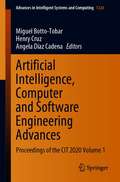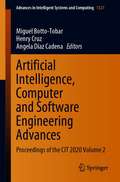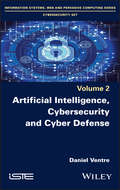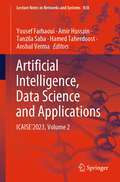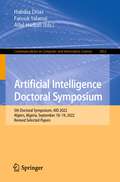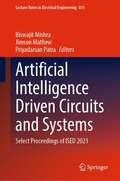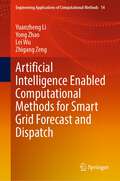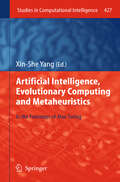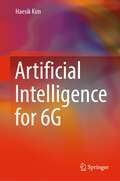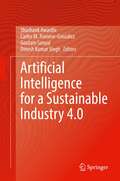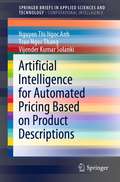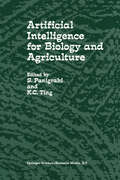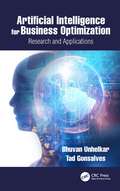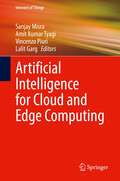- Table View
- List View
Artificial Intelligence, Computational Modelling and Criminal Proceedings: A Framework for A European Legal Discussion (Legal Studies in International, European and Comparative Criminal Law #4)
by Serena QuattrocoloThis book discusses issues relating to the application of AI and computational modelling in criminal proceedings from a European perspective. Part one provides a definition of the topics. Rather than focusing on policing or prevention of crime – largely tackled by recent literature – it explores ways in which AI can affect the investigation and adjudication of crime. There are two main areas of application: the first is evidence gathering, which is addressed in Part two. This section examines how traditional evidentiary law is affected by both new ways of investigation – based on automated processes (often using machine learning) – and new kinds of evidence, automatically generated by AI instruments. Drawing on the comprehensive case law of the European Court of Human Rights, it also presents reflections on the reliability and, ultimately, the admissibility of such evidence. Part three investigates the second application area: judicial decision-making, providing an unbiased review of the meaning, benefits, and possible long-term effects of ‘predictive justice’ in the criminal field. It highlights the prediction of both violent behaviour, or recidivism, and future court decisions, based on precedents. Touching on the foundations of common law and civil law traditions, the book offers insights into the usefulness of ‘prediction’ in criminal proceedings.
Artificial Intelligence, Computer and Software Engineering Advances: Proceedings of the CIT 2020 Volume 1 (Advances in Intelligent Systems and Computing #1326)
by Miguel Botto-Tobar Henry Cruz Angela Díaz CadenaThis book constitutes the proceedings of the XV Multidisciplinary International Congress on Science and Technology (CIT 2020), held in Quito, Ecuador, on 26–30 October 2020, proudly organized by Universidad de las Fuerzas Armadas ESPE in collaboration with GDEON. CIT is an international event with a multidisciplinary approach that promotes the dissemination of advances in Science and Technology research through the presentation of keynote conferences. In CIT, theoretical, technical, or application works that are research products are presented to discuss and debate ideas, experiences, and challenges. Presenting high-quality, peer-reviewed papers, the book discusses the following topics:Artificial IntelligenceComputational ModelingData CommunicationsDefense EngineeringInnovation, Technology, and SocietyManaging Technology & Sustained Innovation, and Business DevelopmentModern Vehicle TechnologySecurity and CryptographySoftware Engineering
Artificial Intelligence, Computer and Software Engineering Advances: Proceedings of the CIT 2020 Volume 2 (Advances in Intelligent Systems and Computing #1327)
by Miguel Botto-Tobar Henry Cruz Angela Díaz CadenaThis book constitutes the proceedings of the XV Multidisciplinary International Congress on Science and Technology (CIT 2020), held in Quito, Ecuador, on 26–30 October 2020, proudly organized by Universidad de las Fuerzas Armadas ESPE in collaboration with GDEON. CIT is an international event with a multidisciplinary approach that promotes the dissemination of advances in Science and Technology research through the presentation of keynote conferences. In CIT, theoretical, technical, or application works that are research products are presented to discuss and debate ideas, experiences, and challenges. Presenting high-quality, peer-reviewed papers, the book discusses the following topics:Artificial IntelligenceComputational ModelingData CommunicationsDefense EngineeringInnovation, Technology, and SocietyManaging Technology & Sustained Innovation, and Business DevelopmentModern Vehicle TechnologySecurity and CryptographySoftware Engineering
Artificial Intelligence, Cybersecurity and Cyber Defence
by Daniel VentreThe aim of the book is to analyse and understand the impacts of artificial intelligence in the fields of national security and defense; to identify the political, geopolitical, strategic issues of AI; to analyse its place in conflicts and cyberconflicts, and more generally in the various forms of violence; to explain the appropriation of artificial intelligence by military organizations, but also law enforcement agencies and the police; to discuss the questions that the development of artificial intelligence and its use raise in armies, police, intelligence agencies, at the tactical, operational and strategic levels.
Artificial Intelligence, Cybersecurity and Cyber Defence
by Daniel VentreThe aim of the book is to analyse and understand the impacts of artificial intelligence in the fields of national security and defense; to identify the political, geopolitical, strategic issues of AI; to analyse its place in conflicts and cyberconflicts, and more generally in the various forms of violence; to explain the appropriation of artificial intelligence by military organizations, but also law enforcement agencies and the police; to discuss the questions that the development of artificial intelligence and its use raise in armies, police, intelligence agencies, at the tactical, operational and strategic levels.
Artificial Intelligence, Data Science and Applications: ICAISE’2023, Volume 2 (Lecture Notes in Networks and Systems #838)
by Yousef Farhaoui Amir Hussain Tanzila Saba Hamed Taherdoost Anshul VermaThis book is to provide a comprehensive reference for professionals in the field of data science and applications: artificial intelligence, big data, IoT, and blockchain. In summary, this book is expected to function as a helpful resource and manual, enabling readers to navigate the intricate domain of artificial intelligence, the Internet of things (IoT), and blockchain in smart environments. This book covers many topics related to integrating AI, IoT, blockchain, and smart environments. It begins by laying a solid foundation, introducing each technology's fundamental concepts and principles. Subsequent chapters explore applications and real-world use cases, demonstrating how AI, IoT, and blockchain can effectively address critical challenges within data science and applications.
Artificial Intelligence Doctoral Symposium: 5th Doctoral Symposium, AID 2022, Algiers, Algeria, September 18–19, 2022, Revised Selected Papers (Communications in Computer and Information Science #1852)
by Habiba Drias Farouk Yalaoui Allel HadjaliThis volume constitutes selected papers presented during the 5th Artificial Intelligence Doctoral Symposium, AID 2022, held in Algiers, Algeria, in September 2022. The 22 presented full papers were thoroughly reviewed and selected from the 38 qualified submissions. They are organized in the following topical sections: data mining; metaheuristics and swarm intelligence; computer vision; Artificial Intelligence applications; machine and deep learning; NLP and text mining.
Artificial Intelligence Driven Circuits and Systems: Select Proceedings of ISED 2021 (Lecture Notes in Electrical Engineering #811)
by Biswajit Mishra Jimson Mathew Priyadarsan PatraThis book highlights selected papers presented at the 10th International Symposium on Embedded Computing and System Design (ISED) 2021. This symposium provides a platform for researchers to share the latest scientific achievements of embedded computing and system design. The book is divided into three broad sections. The first section discusses topics like VLSI and testing, circuits and systems with a focus on emerging technologies. The second section discusses topics like embedded hardware and software systems and novel applications. The final section discusses the state-of-the-art technologies involving IoT, artificial intelligence, green and edge computing that demonstrates the issues currently.
Artificial Intelligence Enabled Computational Methods for Smart Grid Forecast and Dispatch (Engineering Applications of Computational Methods #14)
by Yuanzheng Li Yong Zhao Lei Wu Zhigang ZengWith the increasing penetration of renewable energy and distributed energy resources, smart grid is facing great challenges, which could be divided into two categories. On the one hand, the endogenous uncertainties of renewable energy and electricity load lead to great difficulties in smart grid forecast. On the other hand, massive electric devices as well as their complex constraint relationships bring about significant difficulties in smart grid dispatch. Owe to the rapid development of artificial intelligence in recent years, several artificial intelligence enabled computational methods have been successfully applied in the smart grid and achieved good performances. Therefore, this book is concerned with the research on the key issues of artificial intelligence enabled computational methods for smart grid forecast and dispatch, which consist of three main parts. (1) Introduction for smart grid forecast and dispatch, in inclusion of reviewing previous contribution of various research methods as well as their drawbacks to analyze characteristics of smart grid forecast and dispatch.(2) Artificial intelligence enabled computational methods for smart grid forecast problems, which are devoted to present the recent approaches of deep learning and machine learning as well as their successful applications in smart grid forecast.(3) Artificial intelligence enabled computational methods for smart grid dispatch problems, consisting of edge-cutting intelligent decision-making approaches, which help determine the optimal solution of smart grid dispatch. The book is useful for university researchers, engineers, and graduate students in electrical engineering and computer science who wish to learn the core principles, methods, algorithms, and applications of artificial intelligence enabled computational methods.
Artificial Intelligence Enabled Signal Processing based Models for Neural Information Processing
by Ram Bilas Pachori Rajesh Kumar TripathyThe book provides details regarding the application of various signal processing and artificial intelligence-based methods for electroencephalography data analysis. It will help readers in understanding the use of electroencephalography signals for different neural information processing and cognitive neuroscience applications. The book: Covers topics related to the application of signal processing and machine learning-based techniques for the analysis and classification of electroencephalography signals Presents automated methods for detection of neurological disorders and other applications such as cognitive task recognition, and brain-computer interface Highlights the latest machine learning and deep learning methods for neural signal processing Discusses mathematical details for the signal processing and machine learning algorithms applied for electroencephalography data analysis Showcases the detection of dementia from electroencephalography signals using signal processing and machine learning-based techniques It is primarily written for senior undergraduates, graduate students, and researchers in the fields of electrical engineering, electronics and communications engineering, and biomedical engineering.
Artificial Intelligence Enabled Signal Processing based Models for Neural Information Processing
The book provides details regarding the application of various signal processing and artificial intelligence-based methods for electroencephalography data analysis. It will help readers in understanding the use of electroencephalography signals for different neural information processing and cognitive neuroscience applications. The book: Covers topics related to the application of signal processing and machine learning-based techniques for the analysis and classification of electroencephalography signals Presents automated methods for detection of neurological disorders and other applications such as cognitive task recognition, and brain-computer interface Highlights the latest machine learning and deep learning methods for neural signal processing Discusses mathematical details for the signal processing and machine learning algorithms applied for electroencephalography data analysis Showcases the detection of dementia from electroencephalography signals using signal processing and machine learning-based techniques It is primarily written for senior undergraduates, graduate students, and researchers in the fields of electrical engineering, electronics and communications engineering, and biomedical engineering.
Artificial Intelligence, Ethics and the Future of Warfare: Global Perspectives
by Kaushik RoyThis volume examines how the adoption of AI technologies is likely to impact strategic and operational planning, and the possible future tactical scenarios for conventional, unconventional, cyber, space and nuclear force structures. In addition to developments in the USA, Britain, Russia and China, the volume also explores how different Asian and European countries are actively integrating AI into their military readiness. It studies the effect of AI and related technologies in training regimens and command structures. The book also covers the ethical and legal aspects of AI augmented warfare.The volume will be of great interest to scholars, students and researchers of military and strategic studies, defence studies, artificial intelligence and ethics.
Artificial Intelligence, Ethics and the Future of Warfare: Global Perspectives
by Kaushik RoyThis volume examines how the adoption of AI technologies is likely to impact strategic and operational planning, and the possible future tactical scenarios for conventional, unconventional, cyber, space and nuclear force structures. In addition to developments in the USA, Britain, Russia and China, the volume also explores how different Asian and European countries are actively integrating AI into their military readiness. It studies the effect of AI and related technologies in training regimens and command structures. The book also covers the ethical and legal aspects of AI augmented warfare.The volume will be of great interest to scholars, students and researchers of military and strategic studies, defence studies, artificial intelligence and ethics.
Artificial Intelligence, Evolutionary Computing and Metaheuristics: In the Footsteps of Alan Turing (Studies in Computational Intelligence #427)
by Xin-She YangAlan Turing pioneered many research areas such as artificial intelligence, computability, heuristics and pattern formation. Nowadays at the information age, it is hard to imagine how the world would be without computers and the Internet. Without Turing's work, especially the core concept of Turing Machine at the heart of every computer, mobile phone and microchip today, so many things on which we are so dependent would be impossible.2012 is the Alan Turing year -- a centenary celebration of the life and work of Alan Turing. To celebrate Turing's legacy and follow the footsteps of this brilliant mind, we take this golden opportunity to review the latest developments in areas of artificial intelligence, evolutionary computation and metaheuristics, and all these areas can be traced back to Turing's pioneer work. Topics include Turing test, Turing machine, artificial intelligence, cryptography, software testing, image processing, neural networks, nature-inspired algorithms such as bat algorithm and cuckoo search, and multiobjective optimization and many applications. These reviews and chapters not only provide a timely snapshot of the state-of-art developments, but also provide inspiration for young researchers to carry out potentially ground-breaking research in the active, diverse research areas in artificial intelligence, cryptography, machine learning, evolutionary computation, and nature-inspired metaheuristics. This edited book can serve as a timely reference for graduates, researchers and engineers in artificial intelligence, computer sciences, computational intelligence, soft computing, optimization, and applied sciences.
Artificial Intelligence, Fintech, and Financial Inclusion (Innovations in Big Data and Machine Learning)
by Rajat Gera Djamchid Assadi Marzena StarnawskaThis book covers big data, machine learning, and artificial intelligence-related technologies and how these technologies can enable the design, development, and delivery of customer-focused financial services to both corporate and retail customers, as well as how to extend the benefits to the financially excluded sections of society.Artificial Intelligence, Fintech, and Financial Inclusion describes the applications of big data and its tools such as artificial intelligence and machine learning in products and services, marketing, risk management, and business operations. It also discusses the nature, sources, forms, and tools of big data and its potential applications in many industries for competitive advantage. The primary audience for the book includes practitioners, researchers, experts, graduate students, engineers, business leaders, and analysts researching contemporary issues in the area.
Artificial Intelligence, Fintech, and Financial Inclusion (Innovations in Big Data and Machine Learning)
by Rajat Gera Djamchid Assadi Marzena StarnawskaThis book covers big data, machine learning, and artificial intelligence-related technologies and how these technologies can enable the design, development, and delivery of customer-focused financial services to both corporate and retail customers, as well as how to extend the benefits to the financially excluded sections of society.Artificial Intelligence, Fintech, and Financial Inclusion describes the applications of big data and its tools such as artificial intelligence and machine learning in products and services, marketing, risk management, and business operations. It also discusses the nature, sources, forms, and tools of big data and its potential applications in many industries for competitive advantage. The primary audience for the book includes practitioners, researchers, experts, graduate students, engineers, business leaders, and analysts researching contemporary issues in the area.
Artificial Intelligence for 6G
by Haesik KimThis textbook introduces Artificial Intelligence (AI) techniques for wireless communications and networks, helping readers to find solutions for communications and network problems using AI. Artificial Intelligence for 6G introduces, in a step-by-step manner, AI techniques such as: unsupervised learning;supervised learning;reinforcement learning; anddeep learning. It explains how these techniques can be used for wireless communications and network systems, particularly in designing and optimizing 6G networks. This book is at the forefront of 6G research, and will be of interest internationally, to graduate students, academics, engineers, and developers who are focused on future development of network systems and mobile communications.
Artificial Intelligence for a Sustainable Industry 4.0
by Shashank Awasthi Carlos M. Travieso-González Goutam Sanyal Dinesh Kumar SinghThis book outlines the recent advancements in the field of artificial intelligence (AI) and addresses how useful it is in achieving truly sustainable solutions. The book also serves as a useful reference literature in developing sustainable engineering solutions to various social and techno-commercial issues of global significance. This book is organized into two sections: section 1 is focused on fundamentals and principles of AI to lay the groundwork for the second section. Section 2 explores the sustainable engineering solutions development using AI, which addresses challenges in various computing techniques and opportunities in engineering design for sustainable development using IoT/AI and smart cities. Applications include waste minimization, re-manufacturing, reuse and recycling technologies using IoT/AI, Industry 4.0, intelligent and smart grid systems, energy conservation using technology, and robotic process automation (RPA). The book is ideal for the engineers, researchers and students interested in how AI can aid in sustainable development applications.
Artificial Intelligence for Air Quality Monitoring and Prediction (AI Applications in Earth Science)
by Amit Awasthi Kanhu Charan Pattnayak Gaurav Dhiman Pushp Raj TiwariThis book is a comprehensive overview of advancements in artificial intelligence (AI) and how it can be applied in the field of air quality management. It explains the linkage between conventional approaches used in air quality monitoring and AI techniques such as data collection and preprocessing, deep learning, machine vision, natural language processing, and ensemble methods. The integration of climate models and AI enables readers to understand the relationship between air quality and climate change. Different case studies demonstrate the application of various air monitoring and prediction methodologies and their effectiveness in addressing real-world air quality challenges. Features A thorough coverage of air quality monitoring and prediction techniques. In-depth evaluation of cutting-edge AI techniques such as machine learning and deep learning. Diverse global perspectives and approaches in air quality monitoring and prediction. Practical insights and real-world case studies from different monitoring and prediction techniques. Future directions and emerging trends in AI-driven air quality monitoring. This is a great resource for professionals, researchers, and students interested in air quality management and control in the fields of environmental science and engineering, atmospheric science and meteorology, data science, and AI.
Artificial Intelligence for Air Quality Monitoring and Prediction (AI Applications in Earth Science)
This book is a comprehensive overview of advancements in artificial intelligence (AI) and how it can be applied in the field of air quality management. It explains the linkage between conventional approaches used in air quality monitoring and AI techniques such as data collection and preprocessing, deep learning, machine vision, natural language processing, and ensemble methods. The integration of climate models and AI enables readers to understand the relationship between air quality and climate change. Different case studies demonstrate the application of various air monitoring and prediction methodologies and their effectiveness in addressing real-world air quality challenges. Features A thorough coverage of air quality monitoring and prediction techniques. In-depth evaluation of cutting-edge AI techniques such as machine learning and deep learning. Diverse global perspectives and approaches in air quality monitoring and prediction. Practical insights and real-world case studies from different monitoring and prediction techniques. Future directions and emerging trends in AI-driven air quality monitoring. This is a great resource for professionals, researchers, and students interested in air quality management and control in the fields of environmental science and engineering, atmospheric science and meteorology, data science, and AI.
Artificial Intelligence for Automated Pricing Based on Product Descriptions (SpringerBriefs in Applied Sciences and Technology)
by Nguyen Thi Anh Tran Ngoc Thang Vijender Kumar SolankiThis book highlights artificial intelligence algorithms used in implementation of automated pricing. It presents the process for building automated pricing models from crawl data, preprocessed data to implement models, and their applications. The book also focuses on machine learning and deep learning methods for pricing, including from regression methods to hybrid and ensemble methods. The computational experiments are presented to illustrate the pricing processes and models.
Artificial Intelligence for Business Optimization: Research and Applications
by Bhuvan Unhelkar Tad GonsalvesThis is primarily a business book that discusses the research and associated practical application of artificial intelligence (AI) and machine learning (ML) in order to achieve business optimization (BO). AI comprises a wide range of technologies, databases, algorithms, and devices. This book aims for a holistic approach to AI by focusing on developing business strategies that will not only automate but also optimize business functions, processes, and people’s behaviors. Artificial Intelligence for Business Optimization: Research and Applications explores AI and ML from a business viewpoint with the key purpose of enhancing customer value. It applies research methods and fundamentals from a practitioner’s viewpoint and incorporates discussions around risks and changes associated with the utilization of AI in business. Furthermore, governance risks, privacy, and security are also addressed in this book to ensure compliance with AI/ML applications. Readers should find direct and practical applications of the discussions in this book quite useful in their work environment. Researchers will find many ideas to further explore the applications of AI to business.
Artificial Intelligence for Business Optimization: Research and Applications
by Bhuvan Unhelkar Tad GonsalvesThis is primarily a business book that discusses the research and associated practical application of artificial intelligence (AI) and machine learning (ML) in order to achieve business optimization (BO). AI comprises a wide range of technologies, databases, algorithms, and devices. This book aims for a holistic approach to AI by focusing on developing business strategies that will not only automate but also optimize business functions, processes, and people’s behaviors. Artificial Intelligence for Business Optimization: Research and Applications explores AI and ML from a business viewpoint with the key purpose of enhancing customer value. It applies research methods and fundamentals from a practitioner’s viewpoint and incorporates discussions around risks and changes associated with the utilization of AI in business. Furthermore, governance risks, privacy, and security are also addressed in this book to ensure compliance with AI/ML applications. Readers should find direct and practical applications of the discussions in this book quite useful in their work environment. Researchers will find many ideas to further explore the applications of AI to business.
Artificial Intelligence for Cloud and Edge Computing (Internet of Things)
by Vincenzo Piuri Sanjay Misra Lalit Garg Amit Kumar TyagiThis book discusses the future possibilities of AI with cloud computing and edge computing. The main goal of this book is to conduct analyses, implementation and discussion of many tools (of artificial intelligence, machine learning and deep learning and cloud computing, fog computing, and edge computing including concepts of cyber security) for understanding integration of these technologies. With this book, readers can quickly get an overview of these emerging topics and get many ideas of the future of AI with cloud, edge, and in many other areas. Topics include machine and deep learning techniques for Internet of Things based cloud systems; security, privacy and trust issues in AI based cloud and IoT based cloud systems; AI for smart data storage in cloud-based IoT; blockchain based solutions for AI based cloud and IoT based cloud systems.This book is relevent to researchers, academics, students, and professionals.

